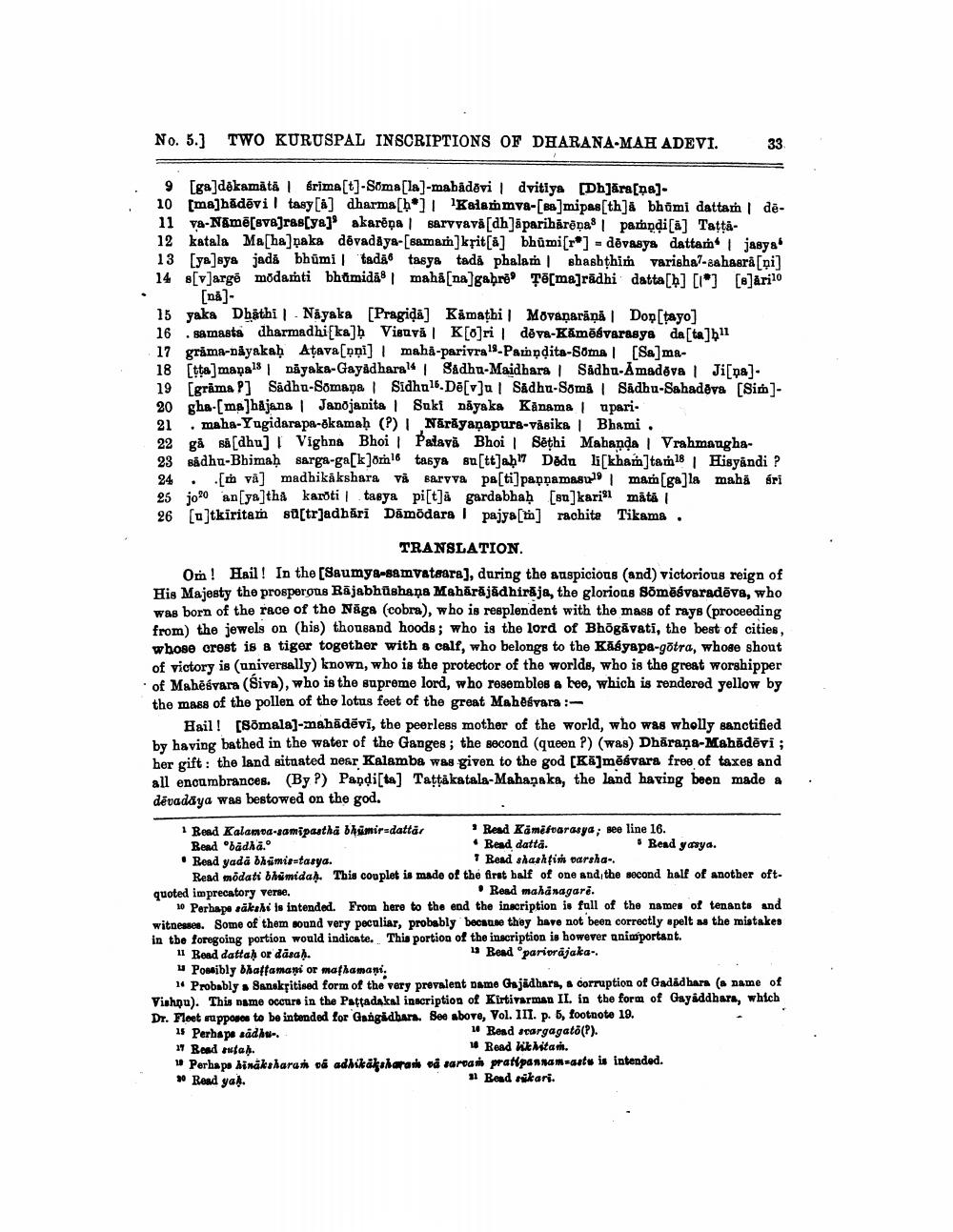________________
No. 5.] TWO KURUSPAL INSCRIPTIONS OF DHARANA-MAH ADEVI.
33
9 [ga]dokamäti Srima[t]-Soma[la]-mabadovi | dvitiya [Dhjära[na]10 [ma]hādēvil tasy[a] dharma[h*] | Kalam mva-[sa]mipas[th]á bhūmi dattam | de11 va-N&mē[svaras[ya] akarēņa saryvavä[dh]äparihärēpa pam di[a] Tattá12 katala Ma[ha]ņaka dēvadaya-samam]ksit[a] bhumi[r*] - dėvasys dattan jasya 13 [yalaya jadá bhümi tada tasya tada phalam shashthim varisha/-sahasra[ņi] 14 8[v]argë modamti bhtimidas | maha[na]gahro Té[ma]rādhi datta [b] [1] [e]arilo
[nå)15 yaka Dhäthi Nayaka [Pragida] Kämathi Movaparāņā | Dop[tayo] 16 samasta dharmadhi[ka] Visuvi K [0]ri | dova-Kämösvarasya da[ta]11 17 gräma-näyakah Atava[ɔni] | maha-parivra -Pam dita-Soma [Sa]ma18 ittamanal nayaka-Gayadhara14 | Sadha-Maidhara | Sadhu-Amadova Ji[na]. 19 [gräma P] Sådhu-Somaņa | Sidha16.Dē[v]ul Sådhu-Somi | Sadhu-Sahadēva [Sin]20 gha-malhajana Janojanita Suki näyaka Kanama upari21. mahs-Yugidarapa-ökamaḥ (?) I Nārāyaṇapura-våsika | Bhami. 22 gå så[dhu] I Vighna Bhoi I Palavă Bhoi Sēthi Mahanda | Vrahmangha23 sådhu-Bhimaḥ sarga-ga[k]orin6 tasya en[tt]ah17 Dadu li[kham]ta u 18 | Hisyandi ? 24 ..[th va] madhikäkshara Vå barvva pasti]pappamas man [ga]la mahä sri 25 jo? anya]tha karoti tasya pi[t]å gardabhaḥ [80] karil mata 26 [n]tkiritam su(tr]adhāri Dāmõdara pajya [] rachite Tikama .
TRANSLATION. Om! Hail! In the [Saumya-8amvatsara), during the auspicious (and) victorious reign of His Majesty the prosperons Rājabhushana Mahārājādhirăje, the glorious Sömēsvaradēva, who was born of the race of the Naga (cobra), who is resplendent with the mass of rays (proceeding from the jewels on (his) thousand hoods; who is the lord of Bhögāvati, the best of cities, whose crest is a tiger together with a calf, who belongs to the KĀ yapa-gotra, whose shout of victory is (universally) known, who is the protector of the worlds, who is the great worshipper . of Mahēśvara (Siva), who is the supreme lord, who resembles a kee, which is rendered yellow by the mass of the pollen of the lotus feet of the great Mahobvara :
Hail! [Somala)-mahādēvi, the peerless mother of the world, who was wholly sanctified by having bathed in the water of the Ganges; the second (queen ?) (was) Dhāraņa-Mahādēvi; her gift : the land situated near Kalamba was given to the god [K]měsvara free of taxes and all encumbrances. (By ?) Papdi(ta) Tattākatala-Mahaņaka, the land having been made a dëvadaya was bestowed on the god.
.
Read Kalamua-samīpaatha bhūmir-dattar Read Kämeftaranya; see line 16. Read badha.
• Read datta.
Bead yasya. . Read yada bhaimir-tasya.
* Read shashfin darsha.. Read mödati hümidan. This couplet is made of the first half of one and the second half of another oftquoted imprecatory verse.
Read mahanagare. 10 Perhapo sakani is intended. From here to the end the inscription is full of the names of tenants and witnesses. Some of them sound very peculiar, probably because they have not been correctly spelt as the mistakes in tbe foregoing portion would indicate. This portion of the inscription is however animportant. 11 Bead dattah or dāsa).
Read pariprajakaPobaibly bhattamani or mathamani.
1. Probably Sanskritised form of the very prevalent dame Gajadhara, a corruption of Gadadhara (s name of Vishnu). This name occurs in the Pattadakal inscription of Kirtivarman II. in the form of Gayaddhara, which Dr. Fleet rappogon to be intended for Gangidbarn. See above, Vol. III. p. 5, footnoto 19. 15 Perhape sadu.
1 Read scargagato(P). 11 Read mutah.
Read hit mitam. 1 Perhapo hinakshara wa adhika sharan så raroan prakpannanass is intended. 30 Read yah.
n Bead sikari.




